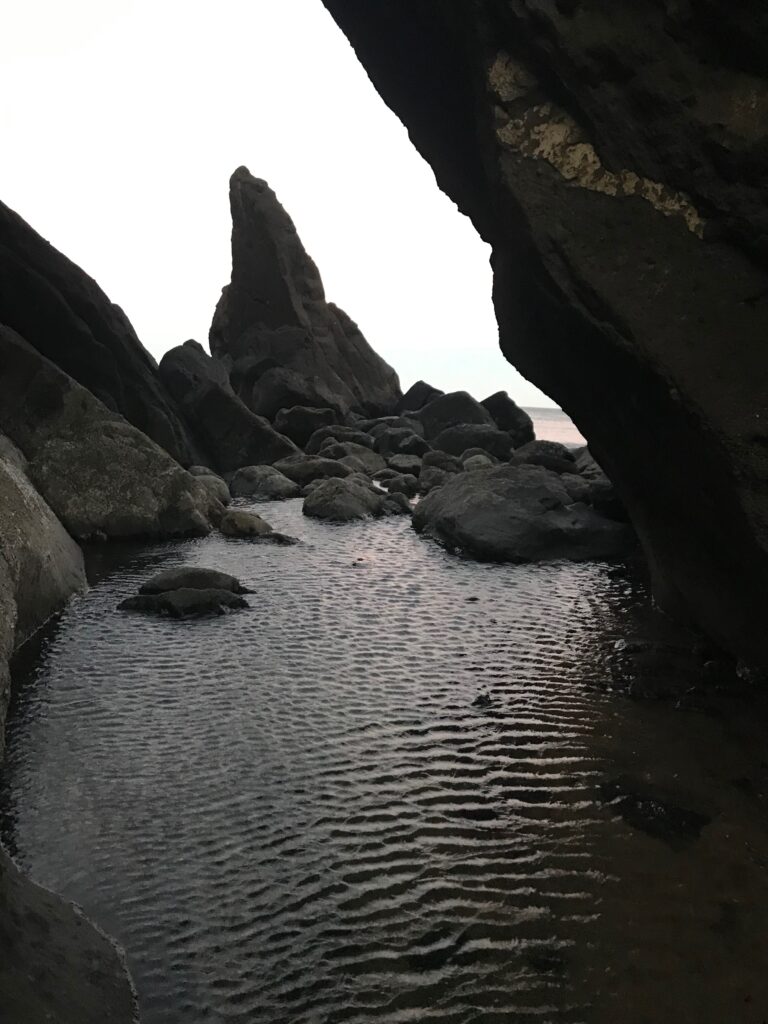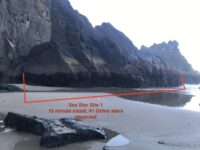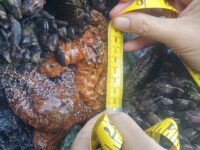Mile 247 Report
South Spit Salmon River, Tillamook/Lincoln county line
October 30, 2023
During this survey there were no visible Ochre Sea Stars in the rocky habitat at the south end of Mile 247.
Report Details
During this survey there were no visible Ochre Sea Stars in the rocky habitat at the south end of Mile 247. There may have been Ochre Sea Stars in the rocky habitat at the time of this survey but due to the combined sand and water level, the south side of the keyhole area of the rocky habitat was not accessible during this survey. There were no visible Ochre Stars in the accessible areas of the rocky habitat. There were some Giant Green Anemones peeking out of the sand and there were small barnacles on many rocks. Other observed species in the rocky habitat included: Bay mussels (Mytilus edulis), sea snails and 1 Common Mure. Similar to previous winter surveys, Mile 247 as a whole and its MDMAP Debris Survey Site was very clean / void of debris. An MDMAP Survey was not conducted during this visit due to a lack of any debris in the site. A green plastic lawn chair (found near the dune grass at the northernmost tip of the spit) and length of blue crab rope (found at the back barrier just north of the rocky habitat at the south end) were removed from the beach during this survey.
Conditions
Temperature: 51 F. Cloud Cover: Sunny. Wind Velocity: Calm/Light. Tide Level: 1.95 feet.
Human Activities
Number of people: 1. Walking or running: 1.
Concerns
Litter
Notable Wildlife
During the Mile 247 survey conducted on 09/14/23, I saw a mole crab for the first time. During this survey I noted about 10 mole crab casings smaller than the live crab observed on 09/14/23 in the wrack line of Mile 247 about a quarter mile from the tip of the sand spit. There was also a single Common Murre shorebird in the rocky habitat at the south end of the mile. It was tucked in between several rocks approximately four feet back from the tide line. It alternated between stretching its wings and budging its body against the rock in front of it and made about 1 foot of progress up the rock during the time it was observed (approximately 5 minutes). I was unsure if it was injured or a juvenile learning to fly. The Murre didn't have any injuries that I could see from where I was standing (approximately 10 feet away).
Beached Birds
1 live Common Mure, no visible leg band.
Driftline Content
Seaweeds and seagrass, Animal casings (e.g., crab, shrimp molt), Wood pieces, Marine debris (plastic, styrofoam, etc. washing in from the sea), Ocean-based debris (from fishing boats, ship trash, etc.). There was some white plastic cording in the wrack line at the south end (north of the rocky habitat) this same cord was observed during the 09/14/23 survey. The cord was brittle and broke when pulled on but what could be removed was taken off the beach. There were some casings from mole crabs (about 10) in the wrack line approximately a quarter mile down from the northernmost tip of the sand spit. There was a harvested piece of pressure treated lumber approximately 8"x2" in size in the wrack line as well. There was a lack of any plastics in the wrack line during this survey; during previous surveys at Mile 247 there has been a significant amount of microplastics (nurdles, bits of broken hard plastics and foam) in the wrack line of Mile 247.










Report Images
All Mile 247 Reports
Mile 247
South Spit Salmon River, Tillamook/Lincoln county line
Sitka Center team member Nancy and Sitka Center artists in residence Evan, Rose, Katrina, Tim, Maria and M accessed the site via kayak.
Nancy Newman
Mile 247
South Spit Salmon River, Tillamook/Lincoln county line
Sitka Team members and Sitka Center artists in residence accessed Mile 247 via kayak, walked south taking observations of the beach mile and met Camp Westwind Team members near Mile 247's rocky habitat.
Nancy Newman
Mile 247
South Spit Salmon River, Tillamook/Lincoln county line
This CoastWatch survey was conducted by Sitka Team member Nancy and 4 members of the Sitka Center 2024 resident cohort: Thomas, Erin, Christian and Fran.
Nancy Newman
Mile 247
South Spit Salmon River, Tillamook/Lincoln county line
Sitka Center for Art and Ecology team members Nancy and Alison conducted this CoastWatch survey.
Nancy Newman
Mile 247
South Spit Salmon River, Tillamook/Lincoln county line
During this survey there were no visible Ochre Sea Stars in the rocky habitat at the south end of Mile 247.
Nancy Newman
Mile 247
South Spit Salmon River, Tillamook/Lincoln county line
As stated above, notable wildlife on the estuary side of the sand spit included 2 herons, 1 harbor seal and many small (approx.
SitkaCenter21
Mile 247
South Spit Salmon River, Tillamook/Lincoln county line
The group of 6 survey participants consisted of Sitka Center & CoastWatch staff, and community members.
SitkaCenter21
Mile 247
South Spit Salmon River, Tillamook/Lincoln county line
The site was accessed by kayak and the survey team walked around the north end of the sand spit to the ocean side of the monitored mile.
SitkaCenter21








